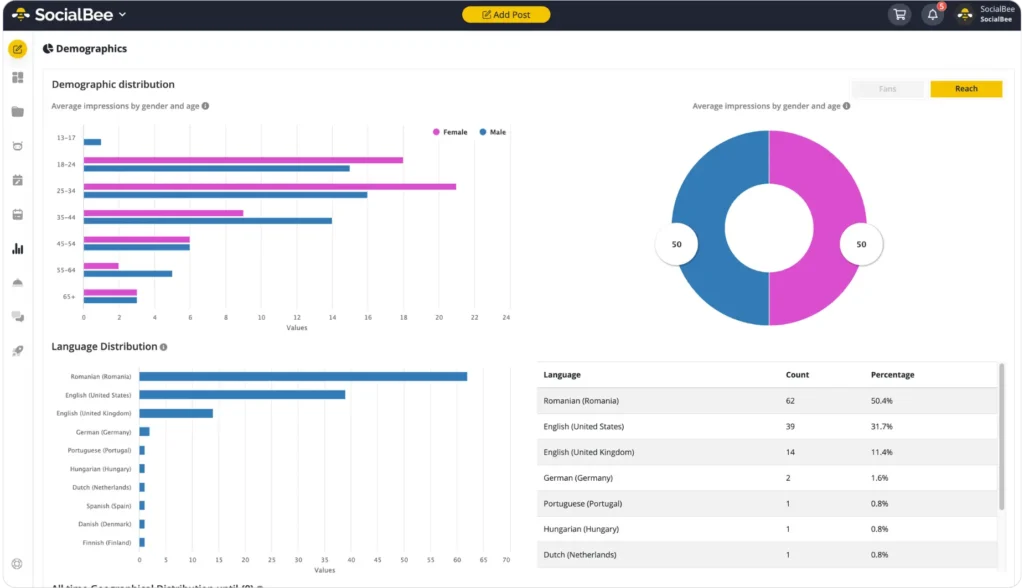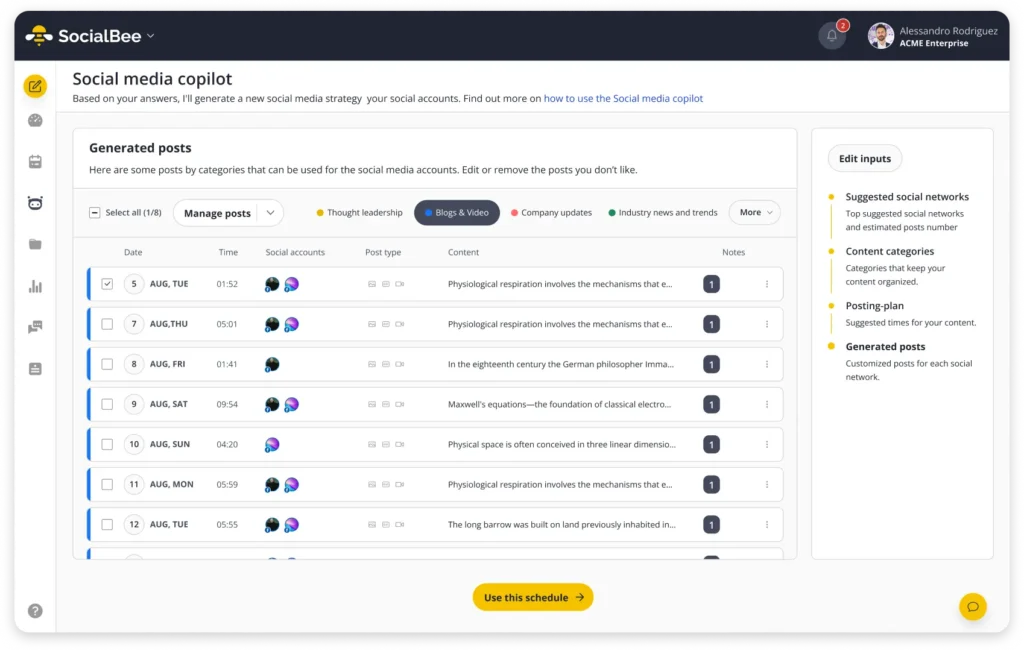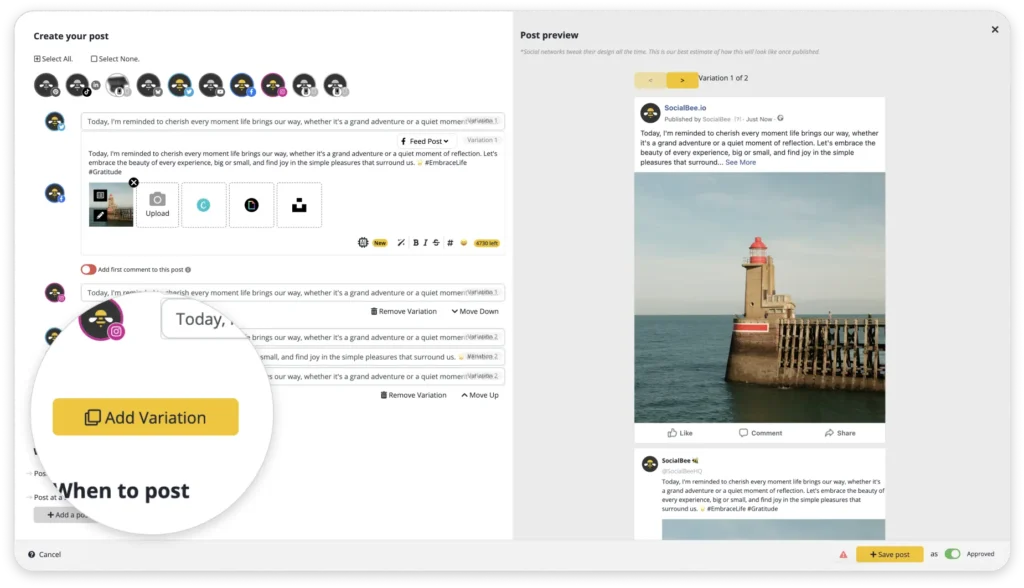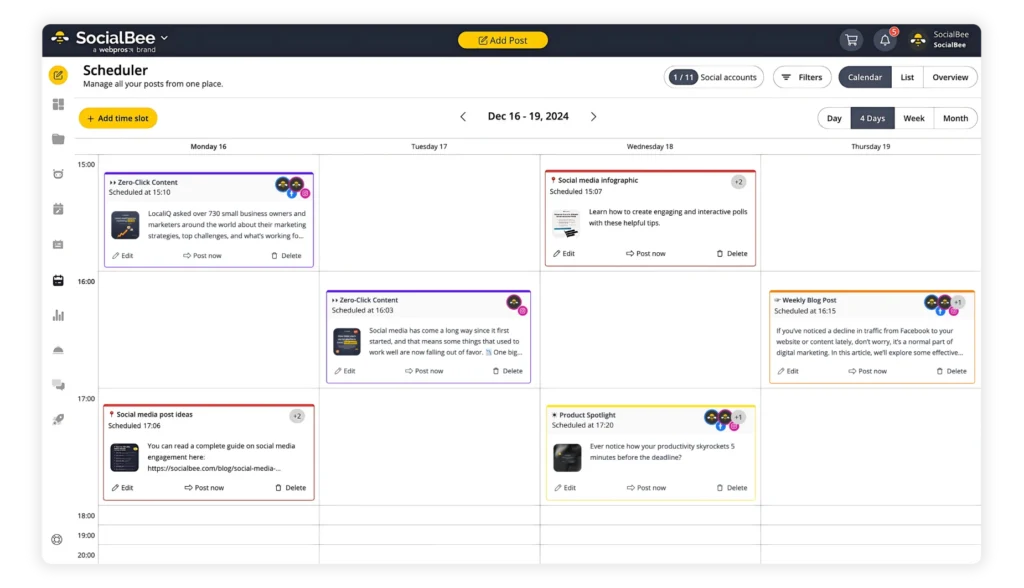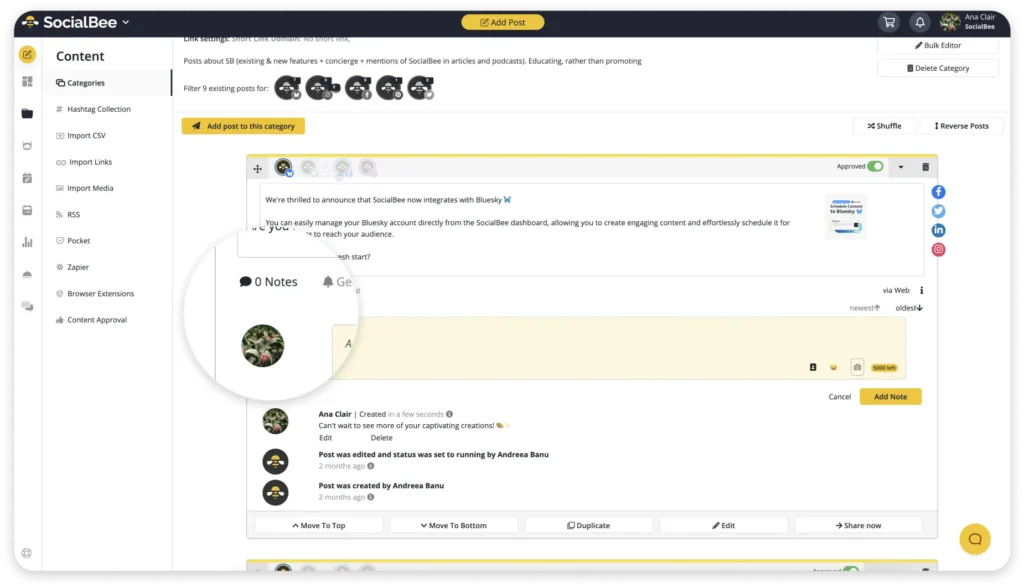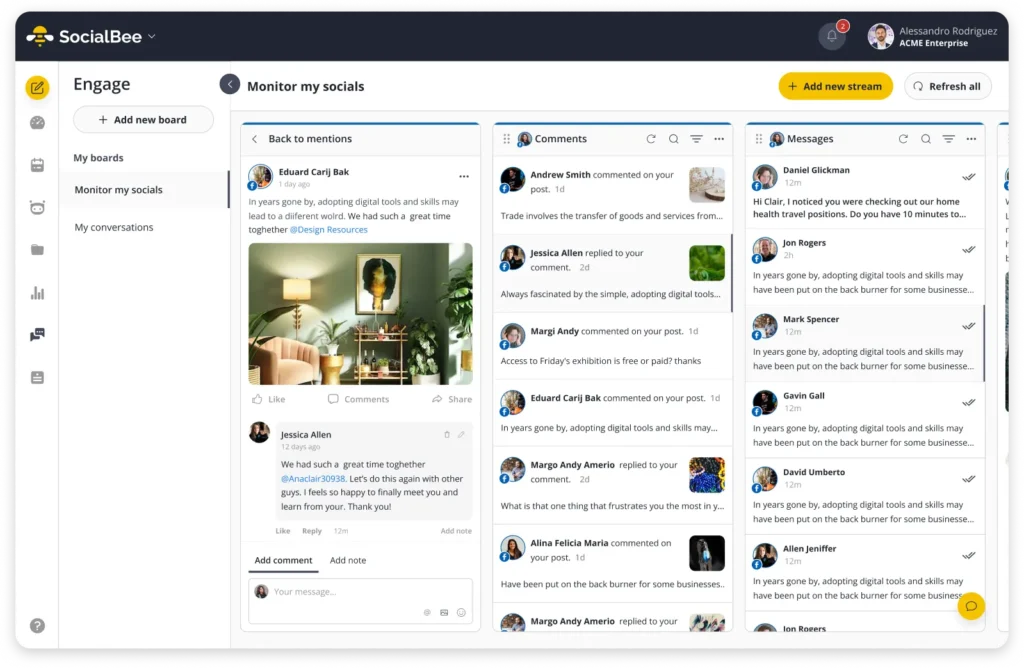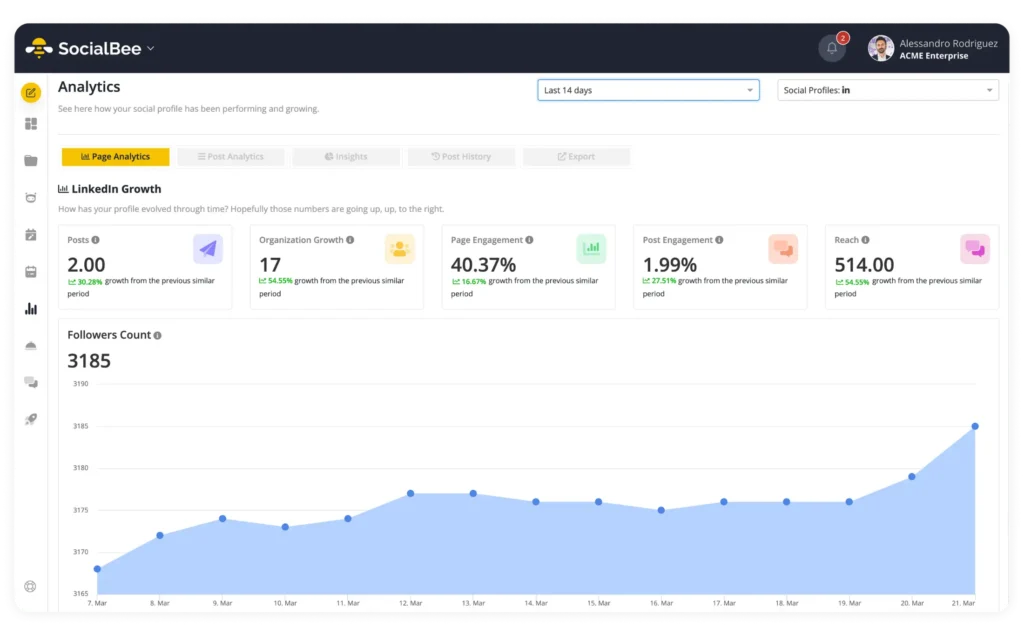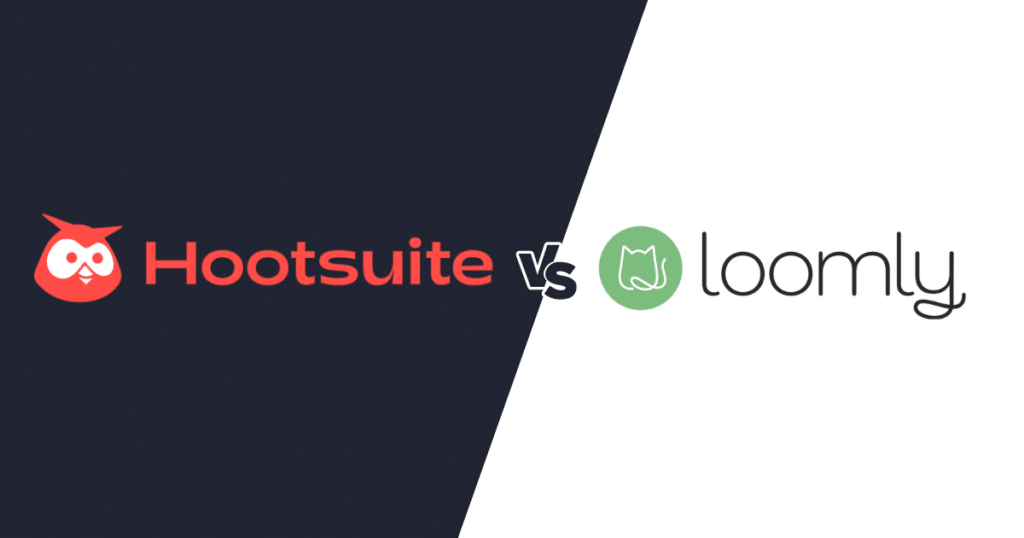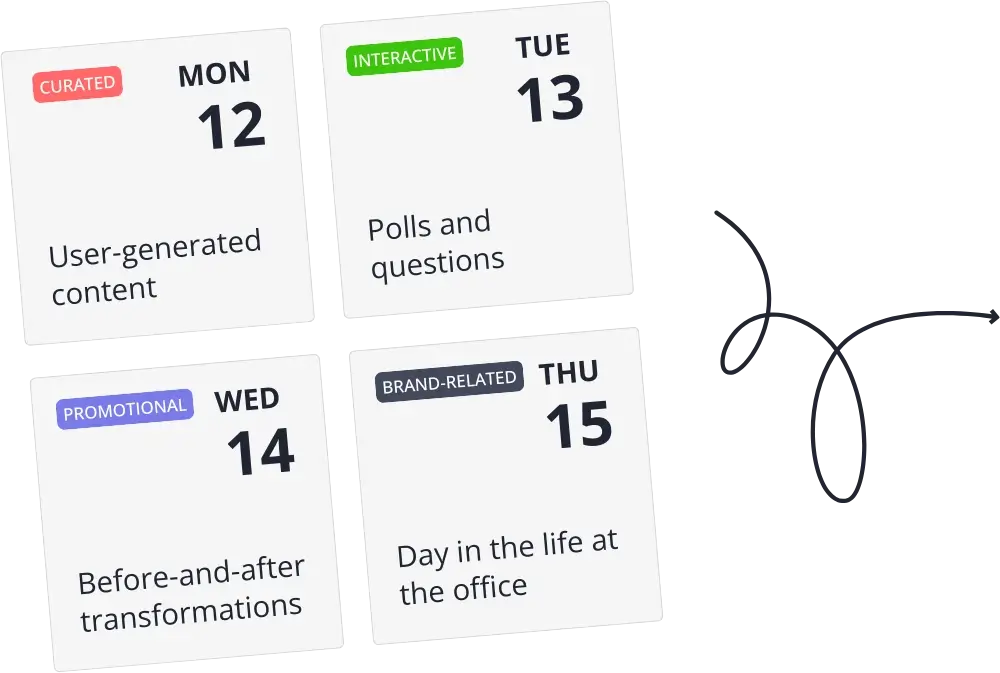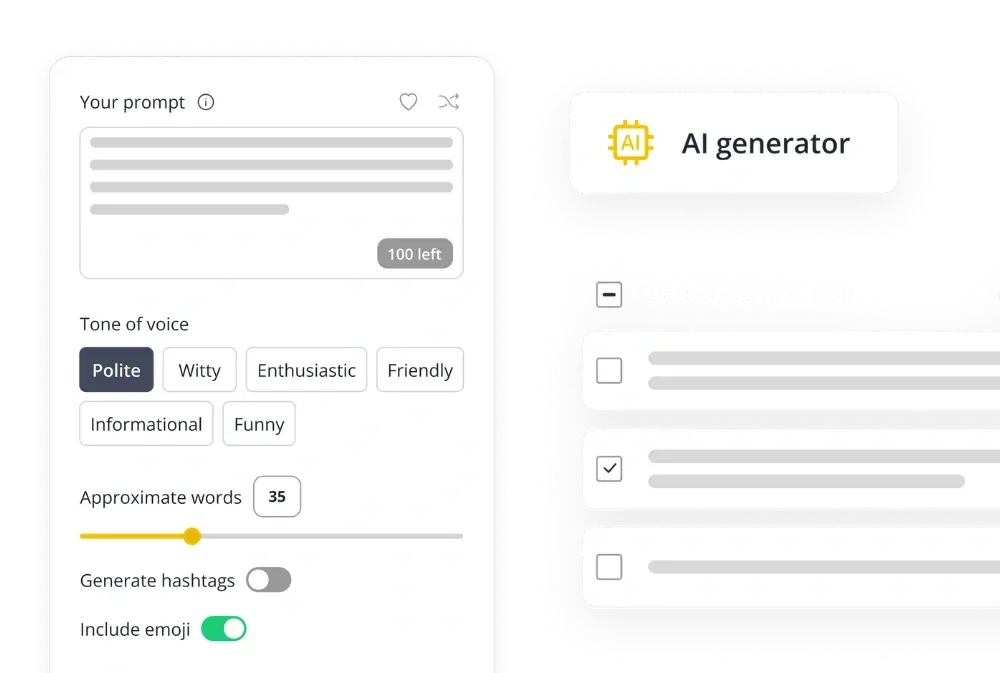
Content Writer at SocialBee
What is social media management, and why does it matter?
Social media is where people discover brands, build connections, and make decisions. Managing it well means staying organized, creating content that resonates, and tracking what works. But let’s be honest, it’s not always easy to keep up.
This guide walks you through the basics of social media management, step by step. We’ll cover everything from planning your posts to reviewing your results, so you can stay on top of things and see real progress.
We’re SocialBee LABS SRL, part of WebPros. We use the information you provide to share relevant content and product updates, as outlined in our Privacy Policy. You can opt out anytime.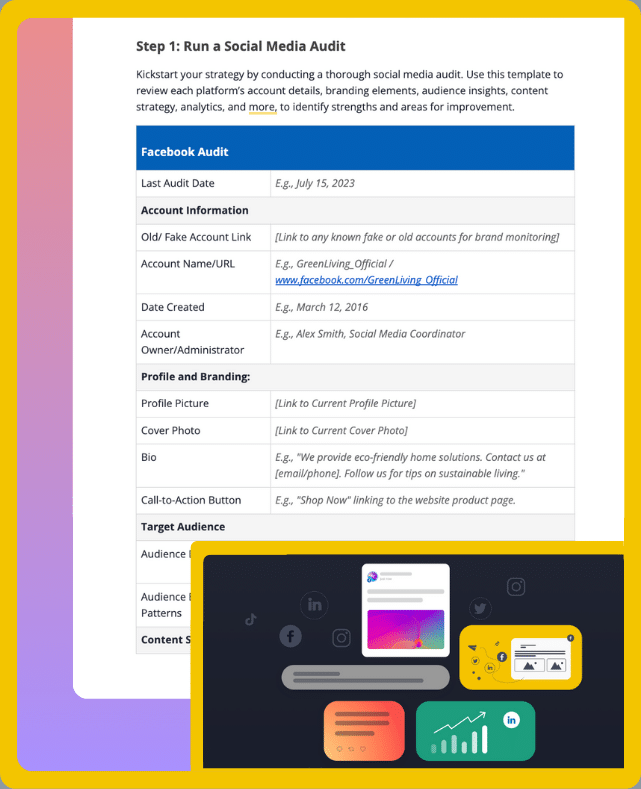
Short Summary
- Social media management involves carefully organizing and overseeing how an organization, creator, or brand presents itself across various social media channels.
- A social media manager is an expert who handles a company or individual’s presence across social media channels.
- Each social media platform has its own set of requirements, including unique content formats, character limits, image specifications, hashtag best practices, and more. Adapting your content to fit these aspects can improve content performance.
- While you might not post as often on one platform compared to another, sticking to a regular schedule is key. It helps keep your audience engaged and shows that you’re active and reliable.
- Assign specific roles within your social media team to ensure that each aspect of your social media presence is managed by someone with the right skills and focus.
- Your content approval process should balance the need for quality control with the agility to respond to conversations on social media.
- Keep an eye on what people are saying about your brand to join social media conversations and guide them in a positive direction.
- When diving into social media ads, begin by defining clear goals. Then, allocate a budget that reflects their importance and potential ROI. Start small, test, and adjust as you gather data on what works.
What Is Social Media Management?
Social media management involves carefully organizing and overseeing how an organization, creator, or brand presents itself across various social media channels.
It consists of planning, creating, and publishing content across various social media networks. It also involves engaging with a brand’s audience, monitoring online conversations, analyzing the effectiveness of campaigns, and adjusting strategies based on data-driven insights.
Why Is Social Media Management Important?
With users spending almost 2.5 hours daily on social platforms, the potential for brands to create a meaningful online presence is unparalleled.
Here’s what makes social media management important:
- Brand awareness and reach: Social platforms serve as a megaphone for your brand, showing people who you are and what you do. Proper management ensures your message reaches the right ears, helping you stand out among competitors.
- Engagement and community building: Good social media management turns your brand into a living, breathing online presence. By providing value, sparking discussions, and sharing laughs, you create a vibrant and engaged community.
- Crisis management and reputation control: Whether it’s quickly resolving a customer issue or navigating a PR hiccup, how you handle these moments can serve as proof of your brand’s integrity and dedication.
- Cost-effective marketing: Marketing budgets aren’t infinite. Fortunately, through a good social media strategy, you can reach and engage your audience without breaking the bank, targeting your efforts where they’ll make the most impact.
- Sales and lead generation: With the right approach, you can quickly learn how to draw interest, nurture leads, and seal the deal, while gathering insights into what it is that your customers really want.
What Is a Social Media Manager?
A social media manager is an expert who handles a company or individual’s presence across social media channels.
Here are the main responsibilities of social media managers:
The Daily Tasks of a Social Media Manager | |
| Check Social Media Notifications |
|
| Content Scheduling |
|
| Engagement |
|
| Monitoring |
|
The Weekly Tasks of a Social Media Manager | |
| Content Planning |
|
| Analytics Review |
|
| Strategy Meetings |
|
| Research |
|
The Monthly Tasks of a Social Media Manager | |
| Report Generation |
|
| Profile Optimization |
|
| Campaign Planning |
|
| Professional Development |
|
| Content Library Update |
|
The Tools You Need to Make Social Media Management Easier
Most social media specialists tell you to “stay consistent” and “track performance.” But what they don’t tell you is how to actually manage the day-to-day workload.
That’s what this video covers: 8 underated social media management tools that make your process faster, cleaner, and more manageable, especially if you’re handling multiple accounts and clients.
Watch the video to see how these tools can help you:
- Plan content smarter and faster
- Design at scale without opening Photoshop
- Turn blog posts into videos
- Track hashtags and measure ROI
- Find influencers without endless DMs
One of these tools literally lets you bulk-generate dozens of social media designs from a spreadsheet in minutes.
By the end of the video, you’ll know exactly which tools can help you work more efficiently and avoid wasting time on the small stuff.
The Elements of A Social Media Management Strategy
When attempting to create a social media management strategy, it’s important to have a clear plan that guides every action and decision you make.
Here are the elements of a social media management strategy:
- Social media planning
- Social media content creation
- Social media scheduling
- Social media collaboration
- Social media listening and engagement
- Social media advertising
- Social media analytics and reporting
1. Social Media Planning
Diving into social media management is an exciting opportunity to shape the public’s perception of your brand. To begin, take a step back to thoroughly understand the landscape, your audience, and how your brand fits into the bigger picture.
A. Research Your Target Audience
Begin with a structured analysis of who your audience members are. Start with demographic details such as age, location, and job type. This gives you a basic outline of who your audience is.
Then, delve into psychographic information, which covers their hobbies, values, attitudes, interests, and lifestyle choices. Use tools like social media analytics, conduct market research, and employ surveys to gain insights into what motivates them, their habits, and their preferences.
Monitor their online activities as well. Pay attention to the types of questions they post, the content they engage with most, and the discussions they participate in. This helps you understand their needs, concerns, and what they are passionate about.
Creating social media audience personas doesn’t have to be time-consuming. With SocialBee, it’s pretty straightforward — everything you need, from demographics to what content they prefer, is available in one convenient place.
Engage with your audience from SocialBee’s centralized dashboard.
With SocialBee, you can reply to all your messages, mentions, and comments from a unified dashboard to save time and energy when managing online interactions.
B. Choose Social Media Platforms
Not two platforms are the same, especially when it comes to aligning your social media efforts with your brand’s strategic goals.
For example, Instagram and Pinterest are visually-charged platforms, suitable for brands that can present their offerings through images and videos. In contrast, X (Twitter) excels in real-time communication and is perfect for brands looking to engage in conversations and provide timely updates.
However, before diving into every available platform, consider your resources. Can you maintain a strong, consistent presence on multiple platforms? It’s better to focus on a few select platforms than to spread yourself too thin.
PRO TIP: Recognize that some platforms can offer higher engagement rates for your industry than others. Research and identify where brands similar to yours see the most interaction.
C. Develop Content Pillars
Content pillars provide a focused lens through which to view content creation, ensuring diversity without diluting your brand’s message.
First, look at your brand’s values, mission, and unique selling propositions. What is it that you stand for? What message do you want to share with your audience? These core themes should naturally translate into your content pillars.
Remember, simplicity is key. Around 5 content pillars that encapsulate the range of topics your brand will consistently talk about on social media should be enough.
PRO TIP: Each pillar should be actionable, providing clear direction on the type of content you’ll create. For example, instead of a broad pillar, like “sustainability,” a more actionable pillar might be “Tips for Living Sustainably,” which directly suggests content ideas that will engage and provide value to your audience.
Social media managers must identify and cater to different content preferences. This makes understanding and connecting with a diverse audience quite complex.
Yet, there’s a straightforward solution to this challenge: SocialBee’s AI assistant. After you answer a total of 8 questions, we provide optimal platform suggestions, an ideal posting schedule, and ready-to-share posts tailored to your unique requirements.
Take the guesswork out of your social media strategy with SocialBee’s AI assistant.
On top of this, you also get content category suggestions for you to organize your posts in, that you can tweak according to your preferences.
D. Brainstorm Social Media Post Ideas
Look at each content pillar independently and ask yourself:
- What unique angle or perspective can my brand bring to this topic?
- How can I showcase this in a way that’s both valuable and engaging to my audience?
Two heads are always better than one, and this rings true in brainstorming sessions. Involve team members from different departments, as they can bring fresh ideas and unique perspectives to the mix.
PRO TIP: Encourage a free-flowing exchange of ideas, where no input is too outlandish. In some cases, the most off-the-wall idea can be tweaked into a post that truly stands out.
2. Social Media Content Creation
On social media, content reigns supreme. However, creating posts for the sake of it simply won’t work. That’s why you need to craft varied, engaging, and interesting content.
For an added spark of creativity, stay attuned to the latest trends and conversations on social media. Using popular hashtags, participating in viral challenges, and diving into hot topics of discussion can boost your brand’s visibility and relevance.
A. Customize Your Posts for Every Platform
For every platform, consider the optimal content format and presentation. For example, an Instagram post might use emotive storytelling through visuals and captions, whereas the same message on X (Twitter) might be a sharp CTA or a thought-provoking question. On LinkedIn, that message could transform into a more detailed analysis or professional insight.
Additionally, to amplify your content’s impact, learn about the unique features that each social media platform offers. Instagram Stories and Reels, LinkedIn articles, and TikTok challenges are just a few examples.
Remember that each social network has unique language, norms, and user expectations. While your core message may remain consistent across platforms, its expression should be tailored to fit each audience.
B. Curate Content for Social Media
The process of content curation is an essential facet of your social media content creation strategy, providing value through diverse, insightful, and engaging posts.
Focus on reputable and insightful sources that are aligned with your brand’s values. This could be industry blogs, news outlets, thought leaders, or even competitors.
Additionally, add your unique perspective to the content you share, whether through a stimulating question, a key takeaway, or a CTA that invites engagement.
PRO TIP: While curated content can greatly enhance your social media strategy, balance is key. A good rule of thumb is the 80-20 rule: 80% original content that highlights your brand and 20% curated content that adds value and engages your audience.
PRO TIP #2: Always tag the original creator in your re-shared post. This shows respect, fosters relationships, and encourages mutual support.
Crafting captivating captions, designing visuals, and juggling multiple platforms—it’s enough to make anyone’s head spin. And let’s not forget the endless search for relevant content to keep your audience engaged. But, don’t worry – there’s a solution.
With SocialBee‘s AI, turning your ideas into captivating captions and images is a quick task. Plus, you can create different versions of the same post for all your profiles from one place.
SocialBee integrates seamlessly with Canva for stunning designs, Unsplash for high-quality images, and Giphy for fun animations.
Moreover, SocialBee’s Chrome extensions make saving articles and videos for later sharing a breeze. And with blog integration via RSS feeds, curated content is just a click away.
3. Social Media Scheduling
Deciding how often to post on each platform is crucial in crafting a social media strategy that resonates with your audience, ensuring engagement without overwhelming them. Let’s find out how to strike this intricate balance.
A. Establish How Often to Post on Each Platform
Your audience’s content preferences are a key factor in determining your posting frequency. Some audiences might prefer daily updates and interactions, while others could prefer less frequent but more substantial content pieces.
Remember, while the frequency of posts may vary across platforms, consistency in your posting schedule is vital. If you need guidance, check out this article, where we cover not only the best social media platforms to use but also optimal posting hours and frequency.
B. Schedule Posts at the Best Times
The backbone of effective scheduling is data. Each social media platform provides data on when your audience is most active. Start by reviewing these analytics to identify patterns in engagement.
Reserve your most compelling content for the peak times identified through your analysis. This ensures that high-value posts—whether they’re major announcements, engaging videos, or thought leadership articles—receive the attention they deserve.
C. Reshare and Repurpose Your Content
With the rapid nature of social media, it can be easy for followers to miss your posts. Resharing content, especially evergreen posts, can boost visibility and engagement.
Repurposing content, on the other hand, is all about converting a piece of content into alternative formats suitable for sharing across platforms. This maximizes your content’s reach and appeal by catering to the specific preferences of each platform’s audience.
Here’s how to reshare and repurpose your content:
- Break down and build up: A comprehensive blog post can be broken down into a series of posts, infographics, or even short videos, each highlighting a key point or insight. Conversely, a series of related social media posts can be compiled into a detailed blog post or an e-book.
- Cross-platform tailoring: Adapt the format and presentation of your content to fit the norms and expectations of each platform. A LinkedIn article can be summarized in a visually appealing Instagram post or discussed in a Twitter thread.
- Refresh and update: Content that performed well in the past can be updated with new information, insights, or a fresh perspective. This not only breathes new life into your content but also reinforces its value and relevance to your audience.
Managing social media involves understanding not only what content to post but also the optimal timing for each platform. Each network has unique periods of peak audience engagement, and these can shift as platforms update their algorithms or as different audience segments evolve in their online behaviors.
Embracing these challenges can help you tailor your strategy for better engagement and ultimately enhance your connection with your audience.
Thankfully, SocialBee offers suggestions for optimal posting times based on content performance. Additionally, we provide a visual content calendar, streamlining the scheduling process across your favorite channels.
Create, plan, and schedule your social media content across your favorite social channels with SocialBee!
To make things even better, through its re-posting feature, SocialBee enables you to strategically reshare your evergreen content. This way, your best pieces can continue to get attention from your audience, saving you valuable time and resources in the long run.
4. Social Media Collaboration
Assigning specific roles within your social media team ensures that each aspect of your social media presence is managed by someone with the right skills and focus.
Here are the roles you should assign to your social media team:
- Content creators tasked with producing compelling copy, graphics, and video content
- Editors who ensure that content aligns with brand voice is error-free and ready for the public eye
- Strategists who oversee the direction of campaigns, ensuring alignment with overall marketing goals
- Community managers that represent the face of your brand online, engage with comments and messages, and foster community
- Analysts who dig into data, providing insights that guide strategy adjustments.
Once roles are set, establishing a smooth content approval process is crucial. This workflow should balance the need for quality control with the agility to respond to conversations on social media.
Here are the key components of a social media content approval process:
- Content calendar: Use a shared calendar to enhance the visibility of what’s being published and when.
- Review rounds: Define how many review rounds each piece of content will go through and who is involved at each stage.
- Feedback loops: Ensure there are clear channels for providing constructive feedback that’s timely and actionable.
- Deadlines: Set realistic deadlines that allow for creativity, review, and timely posting, considering the fast-paced nature of social media.
SocialBee offers extensive collaboration features like assigning roles, managing permissions, tagging users, leaving notes, collaborating on content, post approval worflows. On top of that, we provide workspaces that enable users to invite multiple teams to the platform.
Try SocialBee to make social media management a collaborative process.
5. Social Media Listening and Engagement
On social media, communication is a two-way street; how well you listen and respond can make all the difference. This goes to show that treating each interaction as a meaningful conversation can help you cultivate a loyal and engaged community.
A. Reply to Your Comments and Messages
A prompt reply can be the difference between a satisfied client and a missed opportunity. Establish a standard response time that your team commits to, whether it’s within a few hours or by the next business day.
While it might be efficient to have a set of canned responses for common questions, personalization can significantly enhance the impact of your replies. Use the commenter’s name, reference specific parts of their comment or message, and tailor your response to their inquiry or feedback.
PRO TIP #1: A professional tone is crucial, but that doesn’t mean you can’t infuse personality into your replies. A touch of humor, empathy, or warmth can make your interactions more relatable and memorable.
PRO TIP #2: Negative comments or complaints are inevitable, but they offer a chance to demonstrate your brand’s commitment to customer satisfaction. Publicly acknowledge the issue, offer to resolve it privately if necessary, and always keep the conversation respectful.
B. Monitor Your Brand Mentions
Monitoring your brand mentions allows you to participate actively in the narrative of your brand and steer it toward social media success.
To get a comprehensive view of where and how your brand is being talked about online, use dedicated monitoring tools that can be customized to track specific keywords related to your brand and niche.
However, while staying on top of every mention is important, knowing what to zero in on can make your monitoring efforts more strategic:
- Look for trends in the sentiment of mentions—Are they positive, negative, or neutral?
- Then, identify recurring themes or feedback that could inform product development or content strategy.
- Monitor competitor mentions too, as they can offer insights into industry standards and where your brand stands in comparison.
PRO TIP #1: Use brand mentions as opportunities to interact with your audience. Thank those who leave positive feedback, address the concerns of those with negative experiences, and join in on relevant discussions.
PRO TIP #2: One of the critical values of monitoring brand mentions is the early detection of potential crises. Stay alert to shifts in conversation to mitigate potential damage by showcasing your brand’s responsiveness and dedication to customer satisfaction.
SocialBee‘s engagement dashboard consolidates all the interactions with your audience into one user-friendly interface, significantly improving your response times and the depth of your engagement with your audience.
Engage with your audience from SocialBee’s centralized dashboard.
Our engage module supports a wide range of platforms, including Facebook, Instagram, Twitter, LinkedIn, Google Business Profile, and YouTube. This extensive coverage keeps your engagement efforts unified across social media channels.
6. Social Media Advertising
Learning the ropes of social media advertising offers opportunities for growth, engagement, and deepening the connection with your audience. This can steer your social media marketing efforts toward their intended goals with precision and grace.
A. Establish Your Advertising Budget
The foundation of any successful advertising campaign is a well-planned budget. In other words, how much you’re willing to invest to achieve your objectives without capsizing your overall marketing finances?
Start by defining clear goals: Are you looking to boost brand awareness, increase revenue, or grow your social following? With clear objectives in mind, allocate a budget that reflects their importance and potential ROI.
Remember, social media advertising doesn’t require a fortune to be effective—start small, test, and adjust as you gather data on what works.
B. Develop and Launch Advertising Campaigns
With your budget set, it’s time to dive into the creative process of developing your campaigns.
Here are the core elements of a social media advertising campaign:
- Target audience: Leverage insights gathered through social media listening and engagement efforts to pinpoint your target audience. Social platforms offer targeting options that you can customize based on demographics, interests, behaviors, and more.
- Creative elements: Your ads need to stand out, whether through compelling imagery, engaging videos, or persuasive copy. Ensure your creative elements resonate with your target audience and reflect your message clearly.
- Call to action (CTA): Every ad should include a clear CTA, guiding viewers on what step to take next in their journey, whether it’s signing up for a newsletter, checking out your website, or making a purchase.
- Testing: Before launching your campaign to the wider world, conduct A/B testing with different ad versions to see what strikes a chord among your audience.
- Launch: With testing complete, it’s time to launch your campaign. Use the scheduling features of the advertising platforms to ensure your ads are presented at optimal times for engagement.
While all of this may sound complicated, it doesn’t have to be. A straightforward approach similar to this one can help you hit the mark:
A combination of striking visuals, compelling copy, and a concise CTA may just be what your ad needs.
C. Monitor Your Ad Performance
When monitoring ad performance, keep an eye on metrics like CTR (click-through rates), engagement rates, conversion rates, and ROI. These indicators will help you gauge how well your ads are performing against your objectives.
PRO TIP: Be prepared to adjust your campaigns in real-time. If an ad isn’t performing as you’d hoped, feel free to tweak the creative components and targeting options, or even pause the campaign altogether to reassess.
7. Social Media Analytics and Reporting
Begin by defining what you hope to discover or achieve through your analytics. Are you measuring the reach of your brand awareness campaigns, content engagement rates, or the ROI of your advertising spend?
Most social media platforms offer built-in analytics tools that provide a wealth of information about your posts, audience demographics, engagement rates, and more. Familiarize yourself with these tools, understanding which social media metrics they offer and how these align with your objectives.
Social media managers often find it challenging to centralize data from multiple social media accounts. And it’s no surprise, especially when you juggle multiple platforms, and each one has its own set of analytics tools.
If you struggle with this too, you can use a social media management tool like SocialBee to aggregate data across social media accounts, and get a comprehensive view of your digital landscape.
Get a social media management platform like SocialBee to access real-time analytics and make data-driven decisions.
With SocialBee, you can access metrics like clicks, comments, engagement rates, follower counts, impressions, likes, and overall reach. Then you can easily download this data as easily digestible PDF reports.
With tools in hand and objectives in mind, dive into the data. Look for patterns in engagement—what types of content resonate most with your audience? Gauge the performance of past strategies and identify opportunities for optimization and innovation.
Additionally, translating your findings into reports brings clarity and direction to your team and stakeholders.
Here’s what a well-crafted report should contain:
- Key insights relevant to your objectives, such as findings about your target audience, content engagement patterns, etc.
- Data visualizations for easy understanding of social media metrics
- Actionable recommendations based on the analysis of data
- Concise and focused format, avoiding information overload
Remember, the true value of analytics and reporting lies in the actions they inspire. Use the insights gained to refine your content strategy, adjust posting schedules, tailor your messaging to better meet audience needs, or re-allocate your ad budget for maximum impact.
Frequently Asked Questions
A social media manager must have the following skills:
- Content creation: Crafting engaging, platform-specific content
- Strategic planning: Developing and implementing a social media marketing strategy aligned with business goals
- Analytics: Interpreting data to refine strategies and demonstrate ROI
- Community engagement: Interacting with social media followers to build a loyal community
- Trend awareness: Staying updated on social media trends and platform updates
- Crisis management: Handling negative feedback and online crises with tact
Here is how to become a social media manager:
- Learn the basics: Start with courses or certifications in social media management and marketing, or related fields.
- Gain experience: Create content for your personal social media profiles, volunteer for non-profits, or take on internships.
- Build a portfolio: Document your successes and strategies that have driven engagement or solved complex problems.
- Network: Connect with industry professionals via LinkedIn or local events to learn from their experiences and get your foot in the door.
While closely related, social media management and marketing serve distinct roles:
- Social media management revolves around maintaining and growing a brand’s presence on social media channels. This includes content creation, scheduling, engagement, and analytics. It revolves around the day-to-day upkeep and nurturing of a brand’s social media footprint.
- Social media marketing involves using social media channels for specific marketing campaigns aimed at achieving particular business objectives, such as lead generation, sales, or brand awareness. It’s more campaign-focused, leveraging social media ads, promotional strategies, and targeted content to reach broader goals.
Both are integral to a brand’s overall digital strategy, with management laying the groundwork for effective marketing.
Learn the Ropes of Effective Social Media Management with SocialBee!
As we wrap up, one thing is for sure: social media management is about blending creativity with strategy, intuition with analysis, and conversation with marketing. Whether you’re a newbie looking to carve out your space or a seasoned marketer aiming to refresh your strategy, you don’t have to navigate these waters alone.
Tools like SocialBee are here to help you streamline your processes, from scheduling and analytics to content curation and engagement, ensuring you can focus on what truly matters—creating meaningful connections.
Ready to learn the ropes of effective social media management? Dive into SocialBee’s 14-day free trial and discover how it can transform your social media strategy today!


